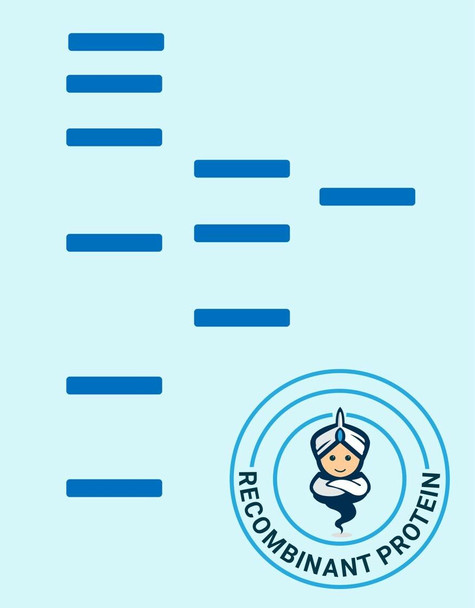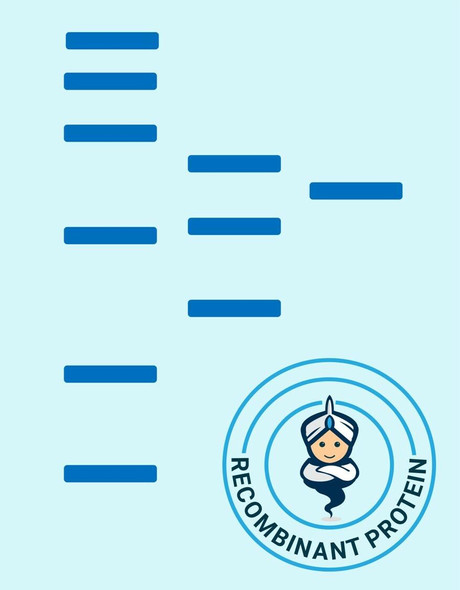Human PYGL Recombinant Protein (RPPB2235)
- SKU:
- RPPB2235
- Product type:
- Recombinant Protein
- Size:
- 5ug
- Species:
- Human
- Target:
- PYGL
- Synonyms:
- GSD6
- Glycogen phosphorylase
- liver form
- Source:
- Escherichia Coli
- Uniprot:
- P06737
Description
| Product Name: | Human PYGL Recombinant Protein |
| Product Code: | RPPB2235 |
| Size: | 5µg |
| Species: | Human |
| Target: | PYGL |
| Synonyms: | GSD6, Glycogen phosphorylase, liver form. |
| Source: | Escherichia Coli |
| Physical Appearance: | Sterile Filtered colorless solution. |
| Formulation: | PYGL protein solution (0.25mg/ml) in phosphate buffered saline (pH7.4), 30% glycerol and 1mM DTT. |
| Stability: | Store at 4°C if entire vial will be used within 2-4 weeks. Store, frozen at -20°C for longer periods of time. For long term storage it is recommended to add a carrier protein (0.1% HSA or BSA).Avoid multiple freeze-thaw cycles. |
| Purity: | Greater than 80.0% as determined by SDS-PAGE. |
| Amino Acid Sequence: | MGSSHHHHHH SSGLVPRGSH MGSEFELRRQ ASMAKPLTDQ EKRRQISIRG IVGVENVAEL KKSFNRHLHF TLVKDRNVATTRDYYFALAH TVRDHLVGRW IRTQQHYYDK CPKRVYYLSL EFYMGRTLQN TMINLGLQNA CDEAIYQLGLDIEELEEIEE DAGLGNGGLG RLAACFLDSM ATLGLAAYGY GIRYEYGIFN QKIRDGWQVE EADDWLRYGNPWEKSRPEFM LPVHFYGKVE HTNTGTKWID TQVVLALPYD TPVPGYMNNT VNTMRLWSAR APNDFNLRDFNVGDYIQAVL DRNLAENISR VLYPNDNFFE GKELRLKQEY FVVAATLQDI IRRFKASKFG STRGAGTVFDAFPDQVAIQL NDTHPALAIP ELMRIFVDIE KLPWSKAWEL TQKTFAYTNH TVLPEALERW PVDLVEKLLPRHLEIIYEIN QKHLDRIVAL FPKDVDRLRR MSLIEEEGSK RINMAHLCIV GSHAVNGVAK IHSDIVKTKV FKDFSELEPDKFQNKTNGIT PRRWLLLCNP GLAELIAEKI GEDYVKDLSQ LTKLHSFLGD DVFLRELAKV KQENKLKFSQFLETEYKVKI NPSSMFDVQV KRIHEYKRQL LNCLHVITMY NRIKKDPKKL FVPRTVIIGG KAAPGYHMAKMIIKLITSVA DVVNNDPMVG SKLKVIFLEN YRVSLAEKVI PATDLSEQIS TAGTEASGTG NMKFMLNGALTIGTMDGANV EMAEEAGEEN LFIFGMRIDD VAALDKKGYE AKEYYEALPE LKLVIDQIDN GFFSPKQPDLFKDIINMLFY HDRFKVFADY EAYVKCQDKV SQLYMNPKAW NTMVLKNIAA SGKFSSDRTI KEYAQNIWNV EPSDLKISLSNESNKVNGN |
Glycogen phosphorylase (PYGL) converts from inactive phosphorylase B to active phosphorylase A by phosphorylation of serine residue 15. Activity of the PYGL enzyme is further regulated by numerous allosteric effectors and hormonal controls. The liver isozyme supplies the glycemic demands of the body in general whereas the brain and muscle isozymes supply just those tissues.
PYGL Human Recombinant produced in E.Coli is a single, non-glycosylated polypeptide chain containing 879 amino acids (1-847 a.a) and having a molecular mass of 100.7kDa.PYGL is fused to a 32 amino acid His-tag at N-terminus & purified by proprietary chromatographic techniques.
| UniProt Protein Function: | PYGL: Phosphorylase is an important allosteric enzyme in carbohydrate metabolism. Enzymes from different sources differ in their regulatory mechanisms and in their natural substrates. However, all known phosphorylases share catalytic and structural properties. Defects in PYGL are the cause of glycogen storage disease type 6 (GSD6). A metabolic disorder characterized by mild to moderate hypoglycemia, mild ketosis, growth retardation, and prominent hepatomegaly. Heart and skeletal muscle are not affected. Belongs to the glycogen phosphorylase family. |
| UniProt Protein Details: | Protein type:Transferase; EC 2.4.1.1; Carbohydrate Metabolism - starch and sucrose Chromosomal Location of Human Ortholog: 14q21-q22 Cellular Component: cytoplasm; plasma membrane; cytosol Molecular Function:glycogen phosphorylase activity; protein homodimerization activity; bile acid binding; purine binding; drug binding; vitamin binding; ATP binding; glucose binding; AMP binding; pyridoxal phosphate binding Biological Process: glycogen metabolic process; glycogen catabolic process; carbohydrate metabolic process; 5-phosphoribose 1-diphosphate biosynthetic process; glucose metabolic process; pathogenesis; glucose homeostasis Disease: Glycogen Storage Disease Vi |
| NCBI Summary: | This gene encodes a homodimeric protein that catalyses the cleavage of alpha-1,4-glucosidic bonds to release glucose-1-phosphate from liver glycogen stores. This protein switches from inactive phosphorylase B to active phosphorylase A by phosphorylation of serine residue 15. Activity of this enzyme is further regulated by multiple allosteric effectors and hormonal controls. Humans have three glycogen phosphorylase genes that encode distinct isozymes that are primarily expressed in liver, brain and muscle, respectively. The liver isozyme serves the glycemic demands of the body in general while the brain and muscle isozymes supply just those tissues. In glycogen storage disease type VI, also known as Hers disease, mutations in liver glycogen phosphorylase inhibit the conversion of glycogen to glucose and results in moderate hypoglycemia, mild ketosis, growth retardation and hepatomegaly. Alternative splicing results in multiple transcript variants encoding different isoforms.[provided by RefSeq, Feb 2011] |
| UniProt Code: | P06737 |
| NCBI GenInfo Identifier: | 6648082 |
| NCBI Gene ID: | 5836 |
| NCBI Accession: | P06737.4 |
| UniProt Secondary Accession: | P06737,O60567, O60752, O60913, Q501V9, Q641R5, Q96G82 A6NDQ4, B4DUB7, F5H816, |
| UniProt Related Accession: | P06737 |
| Molecular Weight: | |
| NCBI Full Name: | Glycogen phosphorylase, liver form |
| NCBI Synonym Full Names: | phosphorylase, glycogen, liver |
| NCBI Official Symbol: | PYGL |
| NCBI Official Synonym Symbols: | GSD6 |
| NCBI Protein Information: | glycogen phosphorylase, liver form |
| UniProt Protein Name: | Glycogen phosphorylase, liver form |
| Protein Family: | Glycogen phosphorylase |
| UniProt Gene Name: | PYGL |
| UniProt Entry Name: | PYGL_HUMAN |










